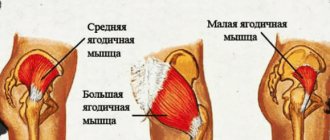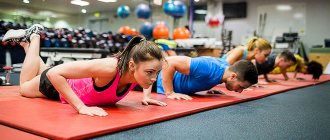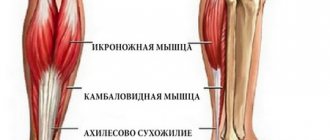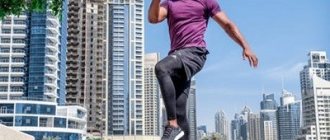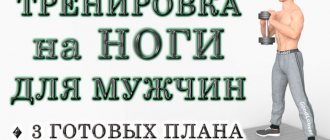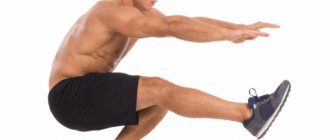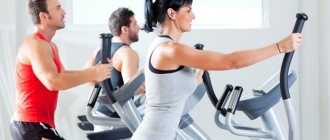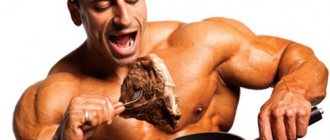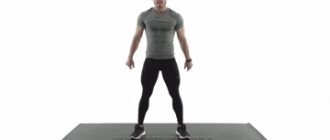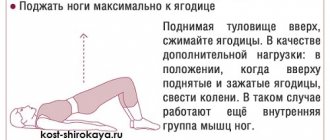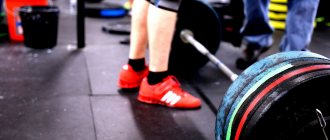Anatomy of the legs
It is unlikely that you can use anything to its full potential without studying the detailed instructions. With exercises for the legs, things are just the same. It is impossible to get the full benefit from each repetition and approach without understanding how the muscles being pumped work. Of course, a thorough study of the function and structure of each muscle is not necessary, but in general terms the structure and task of each muscle zone must be understood.
If we evaluate in general, the concept of “legs” is divided into the following muscles, each of which requires separate exercises:
- Quadriceps femoris muscle (quadriceps) – extends the leg at the knee, takes part in tilting the pelvis forward;
- Biceps femoris muscle (femoral biceps) – bends the leg at the knee, participates in extension of the body;
- The gluteus maximus, medius and minimus muscles (buttocks) – straightening the torso and moving the legs back;
- Gastrocnemius and soleus muscles (calves) - flexion at the ankle joint.
Each group consists of several muscles. For example, the quadriceps muscle includes 4 heads, the biceps, respectively, two bundles. This also needs to be taken into account, because to pump some heads you will have to use separate exercises.
Myths about pumping legs
A lot of myths have formed in strength sports that significantly distort the idea of what proper leg muscle training should look like. As a result, massive and strong legs are very rare among athletes. Many athletes spend time and a lot of effort doing grueling workouts, but do not get even 50% of the desired result. Therefore, it is very important to dispel the main myths regarding leg exercises that bodybuilding accumulates every year.
Myth #1 – You can’t build powerful legs without “secret techniques”
The lack of results for many athletes makes them believe that without “secret techniques” that only professionals know, it is impossible to pump up their legs. However, the reason for such theories is the numerous mistakes that are made not only at the stage of thinking through micro and macro cycles, but also in each individual workout. Add to this technical flaws in the process of performing exercises and you get a formed reason for the failures of tens of thousands of athletes.
Myth No. 2 – The monotony of training does not hinder progress.
Leg muscles are no different from other muscle groups, so any monotony will reduce the rate of progression. As a result, muscle and strength growth will slow down significantly, even if you do the most effective leg exercises every workout. Try to add variety to your training, use different styles (strength, high-repetition, static-dynamic, etc.), include supersets, dropsets and other techniques at least once every two weeks. This will help avoid adaptation, as a result of which the muscles will respond with growth to the received load.
Myth #3 – Squats alone are enough
Of course, barbell squats are one of the cornerstones of all strength sports. Only a couple of other movements can compete with squats in terms of efficiency and benefits. However, squats alone are not enough. Otherwise, everyone would only do one exercise and get huge legs. Remember that leg training is the most voluminous in terms of the number of exercises and load. This is the only way to achieve the desired growth in strength and mass.
Otherwise, it’s enough to train regularly, remember to rest and, of course, provide your muscles with everything they need for growth with the help of quality nutrition.
Types of leg exercisers
Leg exercisers in the gym can be divided into 2 types: for cardio exercises and for strength training. To achieve a positive result from training, it is necessary to use an integrated approach to cardio and strength training.
Cardio exercises for the legs include:
- exercise bike;
- treadmill;
- orbitrek;
- stepper;
- health disk;
- rowing machine;
- climber
Strength training equipment are:
- Smith machine simulator;
- hack machine;
- crossover;
- exercise machines for leg flexion and extension.
Cardio exercises help you lose weight and stimulate your heart muscle. Strength training equipment is aimed at strengthening muscles and giving them definition.
Leg trainers that perform cardio exercises can be used for home workouts. This is due to their compact size. Strength machines are more commonly used in gyms.
This need is due to the fact that strength exercises are safer to do under the guidance of a competent instructor. Self-training on strength structures can lead to various injuries.
Recommendations from professionals
Training the leg muscles of professional athletes is not always an example of ideal work in the gym. It is important to understand that pros have their own priorities and realities, which will not always be relevant. However, some rules and training features for experienced athletes help to correctly use their efforts in the gym and accelerate progression.
#1 – Focus on powerful compound exercises
The more muscle fibers involved during an exercise, the better. And not only for the legs, but also for all the muscles of the body. Therefore, try to pay maximum attention to squats, Romanian deadlifts, lunges and other volumetric movements.
No. 2 – Properly combine basic and isolation exercises
It is important to find a balance between different techniques, exercises, types of load, etc. Try to perform basic exercises with heavy weights in the first half of the workout, when the energy reserves of the muscles have not yet been used up. Isolation movements are best used in the second half of the workout, as finishing moves for a specific muscle or area.
#3 - Don't exercise too often
It is important to take into account the features of leg training when thinking through a program in cycles. The muscle group recovers the slowest, and the legs are constantly under stress throughout the day. This further extends the recovery time. Therefore, think over your rest so that your legs are fully restored between workouts.
#4 – Remember Muscle Balance
Imbalance in muscle development always leads to a slowdown or complete stop of progression. This is a dead-end path, as a result of which you are guaranteed to have to devote months to tighten up lagging muscles. Remember that strength exercises for the legs and buttocks should involve all the muscles of the lower body.
#5 – There are no bad exercises, only incorrect execution.
This suggests that technology is paramount. If some exercise has become popular over the decades of development of strength sports, then it will definitely be used. But only if all technical conditions are met. For example, when you round your back, the Romanian deadlift immediately loses at least half of its effectiveness.
Follow these tips, approach your training wisely and with knowledge of theory, and you will be guaranteed an increase in mass and strength.
The best loads: what to include in your workout
Leg training requires a lot of energy, regularity and motivation. To prepare your body, use dynamic warm-up exercises (running, jumping, etc.). Next, we will look at the most effective exercises that give noticeable results in pumping up the legs and buttocks.
Squats with weight. A popular exercise for basic loading of the entire leg muscles. Technique:
- stand up straight and place your heels slightly wider than your own shoulders, toes pointing outward;
- place the barbell on your shoulders, holding it with your hands;
- lower your body down, bending your knees and leaning forward slightly;
- squat until your thighs are parallel to the floor or lower (depending on your stretching capabilities);
- then, as you exhale, rise back up, tensing the muscles of your legs, back and abs.
Important ! Do not lift your head up - such actions can cause muscle strain in the cervical region.
Deadlift. Connects the muscles of the buttocks and biceps of the thigh to work. Technique:
- grab the barbell with your hands slightly wider than your own shoulders;
- with a straight back, tilt your body forward, moving the bar along your legs downward;
- bring the barbell up to shin level (no need to lower the barbell to the floor) so that you feel a stretch in the back of your legs;
- then slowly lift the bar back up.
Note! Movements should be performed as smoothly as possible - do not quickly lower or raise the body.
Lunges with dumbbells. Works well on the buttocks, front and back of the thigh. Exercise technique:
- pick up dumbbells with a suitable weight, stand up straight;
- take a medium sized step forward;
- squat until a right angle is formed in the knee joint;
- smoothly return to the starting position and take a similar step with the other leg.
When squatting on one leg, the knee should not go beyond the toe, otherwise the load will shift from the muscles to the joints.
Platform press. Activates the work of the inner thighs and buttocks. Technique:
- sit down in the exercise machine and place your feet on the platform - toes pointing slightly to the sides;
- release the lock from the platform and lower it towards you while inhaling;
- as you exhale, push the platform up without fully extending your knees;
- During the exercise, press your lower back firmly against the back of the seat to eliminate unnecessary stress in this area.
Note! The wider you place your feet on the platform, the more your buttocks and inner thighs will be activated.
The best leg exercises
Now let's look at all the leg training exercises that you need to include in your training arsenal. They will be fully enough to progress for years, forgetting about stagnation and plateau. Compound and isolation movements need to be considered separately, so we'll divide the best exercises for leg mass into two categories.
Basic
The classification of basic movements is quite simple. These leg and glute workouts work multiple joints and a large number of muscle fibers. As a rule, this category includes the most complex and basic exercises in strength sports.
Squats with a barbell on your shoulders
For more than 50 years, the mainstay of leg training in any mass program has been squats. This is one of the most versatile movements in strength sports. It is important to understand that squat technique is critical.
Try to squat as low as possible while training your legs, this will engage your glutes and increase the effectiveness of the exercise.
Front Squats
In a leg program, changing the technique of some exercises can completely change the load received. Front squats are by no means an alternative to regular squats and it is incorrect to consider them only as a replacement. Among the obvious advantages are an increased load on the abdominal muscles, the ability to sit down much lower than with a barbell behind your back, as well as less load on the spinal column. This is one of the best exercises for developing leg mass, which can be performed with a barbell, sandbag, kettlebell and other equipment.
Leg press
Any athletes who know how to pump up their legs must do bench presses on the machine. This is an excellent mass-building exercise.
It is very important to adjust the chair correctly and perform the bench press to its full amplitude. Also remember that by placing your feet on the platform, you can change the load and switch it to individual muscles.
Lunges
Lunges are one of the most versatile movements. Such exercises for the leg muscles can be done both in the gym and at home. Moreover, there are many types of lunges (forward, backward, in place, curtsy, with a step to the side, etc.), which completely change the nature of the load. Thanks to this, you can specifically pump absolutely any muscle in the lower body.
Deadlift on straight legs
In terms of effectiveness for leg volume, this exercise comes immediately after squats. Moreover, most often it is combined with squats in supersets and complexes. Straight-legged deadlifts ideally develop the muscles of the buttocks, hamstrings and lower back.
It is important to remember that throughout the entire exercise your back should be perfectly straight. Any distortion will reduce the effectiveness of the traction and can lead to injury.
Hack squats
If the main goal in training is to develop exclusively the muscles of the legs, then hack squats can be an excellent alternative. Firstly, due to the locking of the core and the angle of movement, you can use much more weight than in squats. However, the main advantage of the exercise is the absence of severe stress on the spine.
Standing calf raise
Calves are the main sign of a pumped-up athlete who knows how to train his legs in the gym. Calf raises best replicate the basic function of the calves, which is why this exercise is considered one of the most suitable from an anatomical point of view.
Front Squats
To pump up your legs in the gym, a man needs a variety of loads and even the most effective exercises need to be modified. Changing the position of the barbell can cause many muscles to work completely differently, so try to alternate squats week by week, performing the exercise with the barbell on the front and on the back. It is not recommended to do both options in one workout.
Isolated
This category features leg strength exercises that primarily work only one joint.
Leg extensions
This exercise will always be on the list of the most effective isolation movements for training legs. Extensions are performed in a sitting position, as this allows you to eliminate as much as possible all muscles except the quadriceps.
It is important to remember that the movement uses the quadriceps muscle, so it is important to do it through the full amplitude. Also, you should not take too much weight; in extensions, priority should be given to technique and muscle concentration.
One leg extension
In some gyms, the equipment allows you to do single-leg extensions, which can be very useful for pumping up your legs. A similar technique, in which the entire approach is performed alternately on one leg and the other, makes the exercise more effective. Also, with a similar technique, you can do extensions more cleanly.
Lying leg curls
This is a classic hamstring workout for all bodybuilders, regardless of level. It is best to combine flexion with extension; working out the antagonist muscles significantly increases the benefits of both exercises.
It is important to remember that when performing the exercise, the gluteal muscles are also involved, which is why the movement is often used in circuit training and various complexes.
Seated leg curl
If your gym has a seated curl machine, add this exercise to your leg training routine. Performing curls while sitting is considered more comfortable and allows you to better load the hamstrings, leaving your buttocks out of the work.
Toe press in the simulator
If you need a hard calf workout while training your legs, then your best bet is to use a bench press machine. This will help you lift significant weight without the risk of injury. It is important to remember that you should always install the clamps; this will help you give your all without fear of tearing the platform down.
Standing leg curl
Such simulators are found only in advanced gyms. If it is possible to perform standing bends, then be sure to train in this style and include the exercise in your training program. This is a good option for adding variety to your curls at the gym.
What do we need for proper leg training?
- Correctly selected exercises . We have already decided that the priority will be basic exercises. They will help build muscle mass.
- Progression of loads. In order to avoid stagnation in muscle growth, we will need to constantly add working weight. Let it be little by little, 1 kg at a time, but the progression should be constant. Of course, under no circumstances approach this point with great fanaticism. We add weight gradually as you become more trained.
- Warm up at the beginning of the workout. This is a very important component in the training process. Warm-up will help warm up your muscles for hard work. The same applies to warm-up approaches.
- Stretching at the end of your workout. Remember once and for all - stretching is done only at the end of the workout! But why? Because during stretching, the muscle relaxes, which promotes its speedy recovery and minimizes muscle pain the next day after training. And also, it stretches the muscle fibers that remain in a bound state after hard work on the legs in the gym. If we stretch at the beginning, we will relax the muscles and they are unlikely to be able to work to their maximum.
- Periodization of loads. That is, alternating training on fast (BMW) and slow muscle fibers (MMF). What is the difference between them? BMWs are white and designed for hard work, but get tired quickly. Therefore, they are trained with heavy weights and a small number of repetitions from 1 to 5. MMV is red. On the contrary, they are designed for long work, but with much less weight. We will train them for a high number of repetitions with light weights for 15-20 repetitions.
- Maintaining training progress . Of course, you can skip this step if you have excellent memory and can store a lot of information. But for me it’s easier to write it down. A training notebook will help you with this. In it you will write down: controls, weights, approaches and number of repetitions. Also, your body parameters. Then after some period, for example a month, you will be able to evaluate your progress. It will be difficult to track it in your head.
We recommend reading: Exercises to strengthen the back with scoliosis
Now that we know the training plan, we can start choosing the best exercises.
How to pump up your legs in the gym?
Now let's look at an example of a specific program in order to clearly understand how to pump up your legs in the gym. Of course, this does not mean that you need to use only one training plan. This leg training program will be an excellent basis; over time, you can add new exercises to it or replace individual movements with the same type.
For newbies
The program for beginners should be as simple as possible. The basis is made up of basic exercises; isolating movements are included in the training plan to a limited extent.
Girls can use cyclic training. But in this case, any circuit training for the legs and buttocks should also be based on basic exercises.
A beginner's basic workout should look like this:
- Squats with a barbell – 3*12, 10, 8;
- Romanian deadlift (on straight legs) – 3*12, 10, 8;
- Extensions in a sitting machine – 3*12, 10, 8;
- Bending in a lying machine – 3*12, 10, 8;
- Calf raises while standing or in a machine.
This plan allows beginners to train effectively for up to two years, making changes to the program every one and a half to two months.
For advanced
For experienced athletes, a weight training program for legs should include a more thorough workout of all leg muscles, so the number of exercises will be significantly higher.
It is also important to understand that monotonous exercises will not be enough. Microcycles need to be thought out in such a way that they include strength training of the legs combined with static-dynamic work, if we are talking about mass.
The basic program will look like this:
- Superset: barbell squats and Romanian deadlifts – 4*12, 10, 8, 6 for each movement;
- Lunges (alternate lunges forward and backward for weeks) – 4 * 12, 10, 8, 8 on each leg;
- Leg press;
- Seated leg extension;
- Lying leg curl
- Superset: standing calf raise, sitting calf raise with a barbell – 3*15, 12, 10.
This is a hard leg workout that is guaranteed to give results to experienced athletes who already have a good base and physical training. You also need to periodically add front squats and wide-legged squats to the program.
Leg training program
Of course, ideally, it is better to set aside a separate day for leg training. Since this is a very complex and painstaking work. It will be hard to give it your all, knowing that there is another muscle to pump ahead. But if this is not possible, then pump a small muscle for the second time. Biceps, triceps or shoulders (deltoids) are perfect for this role.
Basic leg workout
- Warm-up: lower body: 5-10 minutes
- Squats with a barbell on the shoulders : 1 warm-up set and 3 working sets for 10-12 reps
- Bench leg press in the machine: (to begin with, neutral positioning of the legs in the middle of the platform, slightly wider than shoulder width is recommended): 1 warm-up and 3 working reps for 12-15 reps
- Romanian deadlift : 1-2 warm-up sets and 3 work sets of 10-12 reps
- Leg bending in the simulator : 3 working repetitions for 10-15 reps. Try to hit the hamstrings as much as possible.
- Calf raises (the option you chose): 1-2 warm-up sets of 12-15 reps and 2-3 working sets for the maximum number of reps. If it goes beyond 20 reps, then increase the weight.
- Stretching: At the end of your workout: try to give your muscles a good stretch. 5-10 minutes.
This training program is designed to develop all muscles of the hind and front legs. If you train 3 times a week, 2 muscle groups in each workout. For example: chest-biceps, back-triceps, legs-shoulders, then it is better to postpone calf raises to some other day.
Targeted training of the quadriceps muscle (quadriceps)
- Warm-up : 5-10 minutes with an emphasis on working muscles.
- Front squats : 1-2 warm-up sets and 3 working sets of 10-12 reps.
- Bench press in a machine with narrow legs : 1 warm-up and 3 working reps for 12 reps.
- Lunges with dumbbells : 3 working sets of 12-15 reps
- Calf raises : 1 warm-up and 3 for the maximum number of times.
- Stretching : focusing on the quadriceps. 5-10 minutes.
This training program is designed to work out the quadriceps in detail. If desired, you can remove the calf raises and replace them with Romanian deadlifts. Then the hamstrings will also be involved, albeit to a lesser extent.
Targeted training of the hamstrings (biceps) and buttocks
- Warm-up: with an emphasis on working muscles for 5-10 minutes.
- Squats with a barbell on the shoulders in sumo style (wide legs) : 1-2 warm-up sets and 3 working sets for 10-15 reps.
- Bulgarian lunges (back leg standing on a hill) : 1 warm-up and 3 working lunges of 15 repetitions.
- Romanian deadlift: 1 warm-up and 2 work for 15 reps.
- Leg curls in the simulator: 3 sets of 15 repetitions.
- Stretching: targeting the back of the thigh for 5-10 minutes.
How to speed up progress using sports nutrition?
It’s not for nothing that many athletes believe that training leg muscles is the most hellish job in the gym that you can imagine. It takes all your strength, requires long-term recovery and giving 200%. Using supplements can significantly speed up not only the rate of progression, but also muscle recovery. First of all, we are talking about the most necessary additives, the effect of which is undeniable:
- Whey Protein;
- Creatine;
- Vitamin and mineral complexes (in any season except summer, if the diet contains a lot of fruits and vegetables);
- Omega-3.
If, in addition to strength work, cardio is included, especially in the morning or evening, then before it you need to drink a portion of BCAA (it is advisable to choose those that contain glutamine).
Supplements that can directly improve performance include:
- Pre-workout complexes (caffeine + green tea can be used separately at the beginning of training);
- Beta-alanine;
- Arginine, to improve pumping.
Many athletes confirm that with such a set the training is superb and even the hardest leg workout will bring joy. If we consider the maximum, then we can add complexes for restoring and improving sleep, as well as CLA, to the list.
For those who are just deciding whether they need sports nutrition, we recorded a video below:
Summary
Remember that even the best leg training program will lose effectiveness over time due to muscle adaptation. To avoid such situations, it is best to use exercises that are similar in type (for example, back squats and front squats, hack machine, etc.). Otherwise, the right food, the right supplements, plenty of sleep and rest, this is the ideal growth formula.
0 37
Did you like the article? Share with friends:
We recommend reading:
How to pump up your legs at home - TOP exercises and effective complexes
How to pump up a girl’s arms at home – exercises with and without dumbbells
How to pump up your forearms at home - the best exercises
Exercises for hands to prevent sagging skin - pump up your hands at home!
Triceps on a block - types of pull-downs and extensions
